» posted on Monday, April 8th, 2013 by Linda Lou Burton
An April Afternoon
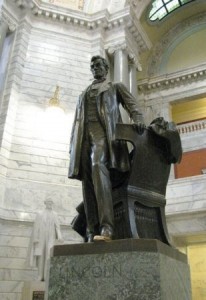 Linda Burton posting from Frankfort, Kentucky – Where can you find statues honoring Abraham Lincoln and Jefferson Davis in the same room? The answer is the rotunda of the state capitol in Frankfort, Kentucky. The bronze statue of Abraham Lincoln stands 14 feet high; his hand rests on a chair; the toe of his shoe, which protrudes slightly from the marble base, is worn to a shine from the hands of admiring passersby. The Lincoln statue occupies the center of the rotunda; just beyond his right shoulder, against the towering marble wall, stands the statue of Jefferson Davis; not nearly so grand in scale or position, yet in keeping with statues of others honored in the space
Linda Burton posting from Frankfort, Kentucky – Where can you find statues honoring Abraham Lincoln and Jefferson Davis in the same room? The answer is the rotunda of the state capitol in Frankfort, Kentucky. The bronze statue of Abraham Lincoln stands 14 feet high; his hand rests on a chair; the toe of his shoe, which protrudes slightly from the marble base, is worn to a shine from the hands of admiring passersby. The Lincoln statue occupies the center of the rotunda; just beyond his right shoulder, against the towering marble wall, stands the statue of Jefferson Davis; not nearly so grand in scale or position, yet in keeping with statues of others honored in the space  that welcomes all to the Kentucky capitol. “Kentucky played a pivotal role in the Civil War,” I read in the brochure I’d picked up at the front desk. “Both the President of the Confederacy, Jefferson Davis (1808-1889), and Union President Abraham Lincoln (1809-1865) were born in Kentucky. The war that pitted state against state and brother against brother was perhaps best represented in Kentucky as portions of the state
that welcomes all to the Kentucky capitol. “Kentucky played a pivotal role in the Civil War,” I read in the brochure I’d picked up at the front desk. “Both the President of the Confederacy, Jefferson Davis (1808-1889), and Union President Abraham Lincoln (1809-1865) were born in Kentucky. The war that pitted state against state and brother against brother was perhaps best represented in Kentucky as portions of the state  supported the efforts of the Confederacy while others supported the efforts of the Union.” (Kentucky was a “border state” during the war; one of four slave states that never seceded; Delaware, Maryland and Missouri were the others). I leaned against the wall to get my bearings and noticed a young boy by the Lincoln statue, hand resting on top of the pedestal. Was he part of a school group? “I’ll bet he just rubbed the toe for luck,” I smiled, as I began to study the brochure. There were three floors to explore, housing all three branches of Kentucky state government. I stared at the opulence above my head; it made me think of France.
supported the efforts of the Confederacy while others supported the efforts of the Union.” (Kentucky was a “border state” during the war; one of four slave states that never seceded; Delaware, Maryland and Missouri were the others). I leaned against the wall to get my bearings and noticed a young boy by the Lincoln statue, hand resting on top of the pedestal. Was he part of a school group? “I’ll bet he just rubbed the toe for luck,” I smiled, as I began to study the brochure. There were three floors to explore, housing all three branches of Kentucky state government. I stared at the opulence above my head; it made me think of France.
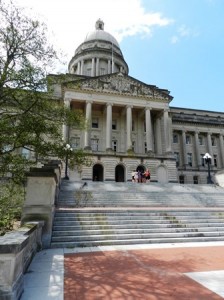 And no wonder, I learned. The building I’m in is the fourth capitol since Kentucky became a state in 1792. A long and bitter quarrel among Louisville, Lexington and Frankfort over which city should be Kentucky’s capital finally ended in 1904, when the legislature voted to spend one million dollars for a new capitol to replace the 1830 building on the old public square in downtown Frankfort. (The first two capitols, used between 1792-1830, had burned.) Frank Mills Andrews was chosen as architect; he was a native of Iowa with a distinguished practice and a fondness for the Beaux Arts style. Andrews’ design was too immense for the downtown square, so the present site across the river in south Frankfort was chosen instead. Ground was broken in 1904 and on June 2, 1910 Kentucky’s new capitol was dedicated with imposing ceremonies.
And no wonder, I learned. The building I’m in is the fourth capitol since Kentucky became a state in 1792. A long and bitter quarrel among Louisville, Lexington and Frankfort over which city should be Kentucky’s capital finally ended in 1904, when the legislature voted to spend one million dollars for a new capitol to replace the 1830 building on the old public square in downtown Frankfort. (The first two capitols, used between 1792-1830, had burned.) Frank Mills Andrews was chosen as architect; he was a native of Iowa with a distinguished practice and a fondness for the Beaux Arts style. Andrews’ design was too immense for the downtown square, so the present site across the river in south Frankfort was chosen instead. Ground was broken in 1904 and on June 2, 1910 Kentucky’s new capitol was dedicated with imposing ceremonies.
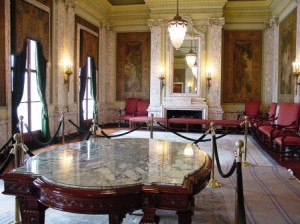 The building is classical French; the staircases are replicas of those of the Opera Garnier in Paris; the walls in the State Reception Room are hand painted to resemble tapestries from the Gobelin Tapestry Guild. The hand-carved Circassian walnut furniture in the room was crafted to resemble 17th-century French Baroque pieces. The elegance of the capitol’s interior was achieved by the generous use of white Georgia marble, gray Tennessee marble and dark green Italian marble. On axis with the rotunda, the grand corridors feature 36 imposing columns of Vermont granite and delicate art glass skylights.
The building is classical French; the staircases are replicas of those of the Opera Garnier in Paris; the walls in the State Reception Room are hand painted to resemble tapestries from the Gobelin Tapestry Guild. The hand-carved Circassian walnut furniture in the room was crafted to resemble 17th-century French Baroque pieces. The elegance of the capitol’s interior was achieved by the generous use of white Georgia marble, gray Tennessee marble and dark green Italian marble. On axis with the rotunda, the grand corridors feature 36 imposing columns of Vermont granite and delicate art glass skylights.
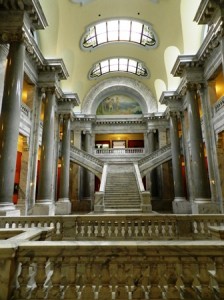 Decorative lunettes above each staircase highlight the entrances to the House and Senate chambers. Painted in oils by T Gilbert White, both depict frontier scenes with Daniel Boone. The east mural portrays Boone and his party catching their first glimpse of the Bluegrass region atop Pilot Knob in 1769. The west mural depicts the negotiations for the Treaty of Sycamore Shoals, which lead to the purchase of Cherokee land that would eventually become Kentucky.
Decorative lunettes above each staircase highlight the entrances to the House and Senate chambers. Painted in oils by T Gilbert White, both depict frontier scenes with Daniel Boone. The east mural portrays Boone and his party catching their first glimpse of the Bluegrass region atop Pilot Knob in 1769. The west mural depicts the negotiations for the Treaty of Sycamore Shoals, which lead to the purchase of Cherokee land that would eventually become Kentucky.
Kentucky’s legislative bodies meet in the House (100 members) and Senate (38 members) chambers. Both chambers continue the classical look of the building,  incorporating scagliola, or faux marble, for their decorative architectural features. The Supreme Court room has solid Honduras mahogany paneling; the elegant coffered ceiling covered in Old Dutch Metal leafing is hammered to imitate old bronze.
incorporating scagliola, or faux marble, for their decorative architectural features. The Supreme Court room has solid Honduras mahogany paneling; the elegant coffered ceiling covered in Old Dutch Metal leafing is hammered to imitate old bronze.
The main part of the Capitol has three floors. The first floor contains the offices of the governor and his staff, secretary of state, and attorney general. I popped into the governor’s office first, for a brief chat with the receptionist before heading 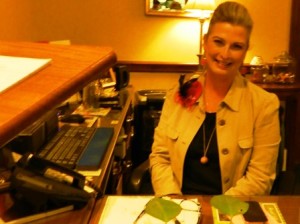 upstairs. The second floor contains the courtroom of the state Supreme Court, as well as the chambers of the justices. The state law library is nearby. The chambers of the House of Representatives and Senate face each other on opposite ends of the third floor. Some high-level legislative offices, such as for the Speaker of the House, also are located there. The Capitol has a partial fourth floor which houses the galleries of the House and Senate, as well as a few offices for legislative committee staffers. The basement level has offices for clerks and maintenance personnel and contains an underground tunnel to the neighboring Capitol Annex building.
upstairs. The second floor contains the courtroom of the state Supreme Court, as well as the chambers of the justices. The state law library is nearby. The chambers of the House of Representatives and Senate face each other on opposite ends of the third floor. Some high-level legislative offices, such as for the Speaker of the House, also are located there. The Capitol has a partial fourth floor which houses the galleries of the House and Senate, as well as a few offices for legislative committee staffers. The basement level has offices for clerks and maintenance personnel and contains an underground tunnel to the neighboring Capitol Annex building.
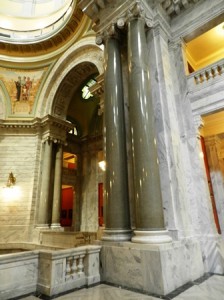 The original design included spaces for murals within the pendentives (the reverse triangular spaces directly beneath the dome); but the murals were not completed until 2009, when Marion and Terry Forcht donated the funds for their completion and installation; the most generous gift in the history of the capitol. The murals were officially unveiled at the June 4, 2010 Centennial Gala. On the first floor again, I peered upwards; I could appreciate their beauty but I couldn’t make out the details, so resorted to reading my brochure.
The original design included spaces for murals within the pendentives (the reverse triangular spaces directly beneath the dome); but the murals were not completed until 2009, when Marion and Terry Forcht donated the funds for their completion and installation; the most generous gift in the history of the capitol. The murals were officially unveiled at the June 4, 2010 Centennial Gala. On the first floor again, I peered upwards; I could appreciate their beauty but I couldn’t make out the details, so resorted to reading my brochure.
Trimmed by a shimmering gilded border, each mural uses different iconic symbols to showcase the Commonwealth of Kentucky. Nature represents the Bounty of the Land – horses, cattle, tobacco, sunflowers; a farmer with a scythe, a bountiful harvest is on the horizon. Industry represents the Power of Commerce – wheels and gears, locomotives and paddlewheels, refineries and bourbon distilleries. Culture represents the Fruits of Knowledge – rock art symbols, dulcimers, a 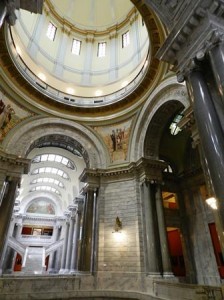 hand-crafted chair, a leather-bound tome. Civitas represents the Light of Progress – the torch of Athena symbolizes truth, enlightenment, and hope; the Lincoln and Davis memorials represent the unique history of Kentucky’s involvement in the Civil War, punctuated by blooming dogwoods on an April afternoon.
hand-crafted chair, a leather-bound tome. Civitas represents the Light of Progress – the torch of Athena symbolizes truth, enlightenment, and hope; the Lincoln and Davis memorials represent the unique history of Kentucky’s involvement in the Civil War, punctuated by blooming dogwoods on an April afternoon.
Opulence and elegance, statements and sentiments, all expressed in ornate style. Feeling a little overpowered by the grand scale of it, I nodded goodbye to Mr Davis and Mr Lincoln and headed outside, on an April afternoon.
Kentucky State Capitol 700 Capitol Avenue, Open Monday-Saturday, 502-564-3449 for tours, http://capitol.ky.gov/Pages/capitoloverview.aspx
